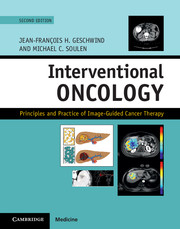Book contents
- Frontmatter
- Contents
- List of contributors
- Section I Principles of oncology
- Section II Principles of image-guided therapies
- Section III Organ-specific cancers – primary liver cancers
- Section IV Organ-specific cancers – liver metastases
- Section V Organ-specific cancers – extrahepatic biliary cancer
- Section VI Organ-specific cancers – renal cell carcinoma
- Section VII Organ-specific cancers – chest
- Section VIII Organ-specific cancers – musculoskeletal
- Section IX Organ-specific cancers – prostate
- Section X Specialized interventional techniques in cancer care
- 28 Vascular access: Venous and arterial ports
- 29 Palliative care and symptom management
- 30 CT-guided neurolysis for cancer-related abdominal and pelvic pain
- 31 Palliative procedures for ascites and effusion
- Index
- References
31 - Palliative procedures for ascites and effusion
from Section X - Specialized interventional techniques in cancer care
Published online by Cambridge University Press: 05 September 2016
- Frontmatter
- Contents
- List of contributors
- Section I Principles of oncology
- Section II Principles of image-guided therapies
- Section III Organ-specific cancers – primary liver cancers
- Section IV Organ-specific cancers – liver metastases
- Section V Organ-specific cancers – extrahepatic biliary cancer
- Section VI Organ-specific cancers – renal cell carcinoma
- Section VII Organ-specific cancers – chest
- Section VIII Organ-specific cancers – musculoskeletal
- Section IX Organ-specific cancers – prostate
- Section X Specialized interventional techniques in cancer care
- 28 Vascular access: Venous and arterial ports
- 29 Palliative care and symptom management
- 30 CT-guided neurolysis for cancer-related abdominal and pelvic pain
- 31 Palliative procedures for ascites and effusion
- Index
- References
Summary
Introduction
The definition of ascites is the pathological accumulation of fluid in the peritoneal cavity. Malignant ascites is accumulation of fluid in the peritoneal cavity as a consequence of cancer. Refractory ascites is when ascites fail to respond to: (1) bed rest; (2) fluid restriction to 1500 mL/day and salt restriction to 80 mmol/day; (3) 400 mg/day spironolactone or 300 mg/day triamterene plus 120 mg/day furosemide for 4 weeks; or (4) when patients are intolerant to medical therapy because of azotemia.
The most common cause of benign and malignant ascites, accounting for nearly 80% of cases, is liver cirrhosis. Malignant ascites is present in approximately 10% of all patients with ascites. The cancers most commonly associated with ascites can be divided into two groups of intra-abdominal (i.e., ovary, stomach, pancreas, and colon) and extra-abdominal (i.e., breast, lung, and lymphoma) malignancies. In approximately 20% of all patients with malignant ascites the primary origin of the tumor is unknown.
The pathophysiology of malignant ascites is multifactorial and not completely clear. The cause of ascites in cancer patients differs from that in patients with cirrhosis. The most common recognized pathophysiology is alteration in vascular permeability of the parietal peritoneum and metastatic spread to the peritoneum or peritoneal carcinomatosis (50%). Vascular endothelial growth factor (VEGF) increases vascular permeability. Multiple reviews have demonstrated high levels of VEGF in patients with malignant ascites, particularly in patients with ovarian, gastric, and colorectal cancers. Other mentioned causes are obstruction of draining lymphatics due to lymphatic invasion (20%; most commonly seen in lymphoma and breast cancer), liver metastasis, resulting in portal vein hypertension (15%), and hormonal mechanisms. Depleted or reduced circulatory blood volume activates the renin–angiotensin–aldosterone system, leading to sodium retention in patients with ascites, including patients with malignant ascites.
Diagnostic tests
A basic metabolic panel, including serum electrolytes, blood urea nitrogen and creatinine, hepatic function panel, including serum albumin, and urinary sodium levels, provides measures of liver function, volume, and nutritional depletion, and helps to guide initial therapy. A diagnostic paracentesis should be performed for cell count with differential, Gram stain with culture, albumin level, and cytology. Cytology is 97% sensitive for carcinomatosis. A serum-ascites albumin gradient > 1.1 gram/dL is 97% accurate for the diagnosis of portal hypertension.
- Type
- Chapter
- Information
- Interventional OncologyPrinciples and Practice of Image-Guided Cancer Therapy, pp. 323 - 332Publisher: Cambridge University PressPrint publication year: 2016



